On her machinima series TimeTravellertm (2008-2013), Skawennati (Tricia Fragnito) describes her exploration of past, present, and future events through a First Nations lens:
“I was thinking about native people and our presence [in cyberspace], and our lack of presence in the future and how people don’t see us in the future. Even we native people don’t seem to see ourselves in the future. It seems to me that we keep longing for the past” (see CBC article).

In order to explore an indigenous futurism, Skawennati utilizes Second Life as a “futuristic medium” in which to set her machinima (see CBC article). A virtual reality social platform, Second Life allowed Skawennati to use avatars, build sets, and dictate different camera angles to film nine episodes of TimeTravellertm. When describing the three iterations of her other project CyberPowWow, Skawennati and Jason Lewis discussed Aboriginal artists and programers building in the “blank spaces” of the existing foundations of cyberspace (2005: 108-109). With TimeTravellertm, Skawennati filled in the blank spaces of Second Life with Indigenous stories. She also extended the reach of Second Life to reach new audiences in physical settings by screening her machinima in film festivals and galleries such as the University of Toronto’s Ryerson Image Centre.
Through setting TimeTravellertm in the 23rd century, Skawennati foresees a future that both celebrates and commercializes Indigenous cultures while it remains connected to the past. The viewer experiences time travel through the eyes of Hunter, a future Mohawk “cold-blooded killer” and “bounty-hunter” who is tired of fighting other peoples wars. As a respite from his present, Hunter dons virtual reality glasses and enters TimeTravellertm in order to experience different moments in Indigenous history.

Skawennati’s explorations of famous events in history, such as the occupation of Alcatraz in 1969, are striking as Hunter and the viewer are able to experience them from within an Indigenous perspective rather than a colonial or newsreel point of view. Her imaginings of the future are perhaps more striking. Hunter’s pride in his Mohawk lineage and the existence of Indigenous sovereignty through the secession of the Iroquois Nations, followed by the other First Nations in Canada foresees a time ahead in which First Nations communities have not disappeared nor been submerged into a multicultural society. Rather, they are alive and sovereign.
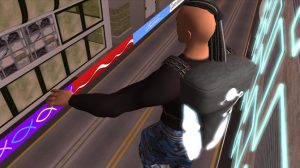
The future is not entirely idyllic, however, as Hunter expresses frustration with “fighting other people’s wars” which could indicate some limits to Indigenous sovereignty. The future is also commercialized as can be seen within the first screenshots of Hunter approaching with his jetpack, zooming past advertisements for Goooooooogle, Nike, and ichthus symbols, perhaps indicating the continuing reaches of Christianity.
The 2112 National Jingle Dance Competition that Hunter and Karahkwenhawi attend is similarly nuanced. The crowd is dismayed that potlatches were once banned and cheers as the flowing-haired MC reminisces that as “record numbers of Indian babies
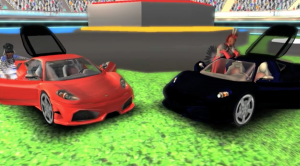
were born in the 21st century, the potlatch grew and thrived.” The stadium setting, the televisation, and the promise of prizes like a trip to Saturn, one billion dollars, and a Ferrari, however, reveal a transitioning of ceremony into consumerism. Skawennati’s imagining of the future is thus both celebratory and hopeful, and somewhat satirical.
It is of note that Skawennati created TimeTravellertm within a context of Indigenous futurism, a genre that joins Indigenous storytelling and science fiction. While science fiction has long perpetuated a narrative of explorer and indigenous ‘other’ across the ‘final frontier,’ Indigenous futurism subverts this story arch. Speculative fiction writer, Nalo Hopkinson of Jamaican-Canadian descent describes the process of integrating creole language and Caribbean oral stories with science fiction:
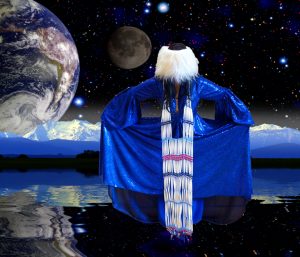
“Take the meme of colonizing the natives and, from the experience of the colonizee, critique it, pervert it, fuck with it, with irony, with anger, with humor and also, with love and respect for the genre of science fiction that makes it possible to think about new ways of doing things” (The New Inquiry).
While Skawennati operates within the medium of the machinima rather than writing, through orienting TimeTravellertm around Hunter and other Indigenous ‘colonizees’ she critiques a colonial imagining of the future. And although she references classic science fiction through Hunter’s jetpack, light saber, and Blade Runner (1982) poster, Skawennati decolonizes the science fiction trope of time traveling to revolve around Indigenous narratives.
There is also a form of escapism in Indigenous futurism as promoted by Skawennati’s fairly hopeful projection of the future in TimeTravellertm. In her article, “Indigenous Cultures of Indigenous Futurisms,” anishinaabe-nehiyaw writer Lindsay Nixon describes Indigenous futurism:
“The future imaginary and its catalogue of science fictive imageries affords Indigenous artists a creative space to respond to the dystopian now, grounding their cultural resurgence in contextual and relational practices.”
Using traditional Indigenous worldviews, storytelling, artforms, and languages, various artists have imagined a more utopian future, moving forward from the

‘dystopian now.’ As mentioned above, Skawennati’s imagining of the future is in
some ways utopian with Indigenous sovereignty and resurgent dancing and music practices. Hunter’s dissatisfaction with his present, however, hints at the imaginary nature of an Indigenous utopian future as he might see himself as living in a ‘dystopian now’ within Skawennati’s ‘utopian future.’
********************************************************************
TimeTravellertm Episode 10: 2014
The tenth episode of TimeTravellertm begins in Hunter and Karahkwenhawi’s large condo overlooking the city. It has been ten years since we last saw the couple entertaining friends in Episode 9. Hunter is away on business, working as an ambassador for TimeTravellertm and Karahkwenhawi is playing with their eight year old daughter.

Hunter and Karahkwenhawi’s daughter is asking about her grandmother who recently passed away. Karahkwenhawi was able to time travel to visit her mother in the hospital before she passed but is still feeling guilty about not having been there more often. As her daughter asks about her grandmother and the early 21st century, Karahkwenhawi feels increasingly disconnected from her past.
“If the Great Secession hadn’t happened yet in your time period, what was it like?” her daughter asks, remembering that the Iroquois Nation and the other First Nations had not yet seceded in her mom’s time period. “What did the Canadian government do? Were people really angry? Were there protests?”
As her daughter asks more and more questions, Karahkwenhawi is struck again by how much she missed by moving to the future with Hunter. Wanting to learn more about her own time period and feel closer to her mother, she decides to do some searching with TimeTravellertm.
Getting a pair of glasses for herself and her daughter, Karahkwenhawi types in “protest” and “21st century.” Hundreds of options pop up on the screen but she chooses “Awalaskenis II” because it is dated 2014, near the time when she left for the future.
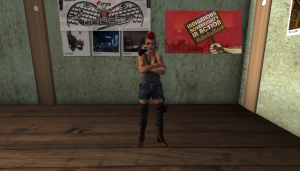
The setting is a room in Ottawa arrayed with posters and other banners, some reading “#IdleNoMore,” or “Decolonize.” Karahkwenhawi and her daughter opt for the “intelligent agent” mode and meet a young woman from the Musqueam Nation. She has travelled all the way from the UBC longhouse with Beau Dick and his companions, visiting various First Nations communities along the way. Bringing sacred objects with them on the journey, they enacted ceremonies while they travelled such as washing coppers.
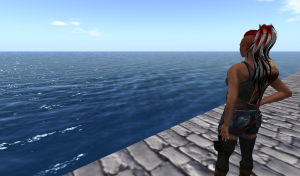
The young woman invites Karahkwenhawi and her daughter to join her at the steps of the capital building where there is going to be a protest and a copper-breaking ceremony.
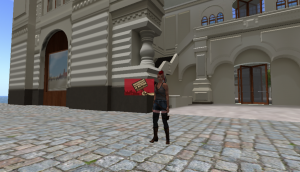
At the capital building a crowd has gathered with signs, masks, and ceremonial objects. Holding up an #IdleNoMore sign, Karahkwenhawi and her daughter watch as Beau Dick and other important men break the Haida copper Taaw.
A woman standing nearby explains that a copper-breaking ceremonies is a shaming rite, traditionally marking a broken relationship in need of repair. Through breaking the copper
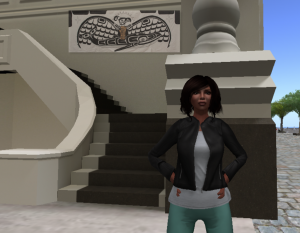
Taaw, the group is passing the burden of wrongdoing to the Canadian government for its history of colonialism and environmental destruction. With this ceremony, the group is indicating the need for repair and reconciliation between the Canadian government and First Nation communities.
After Karahkwenhawi and her daughter return home, they both express excitement over the energy and power of the copper-breaking ceremony. Karahkwenhawi feels closer to home and her mother, recognizing the importance steps that 21st century Indigenous communities took that led to her future in the 23rd century. She also feels a strong desire to help with these movements.

Normally in TimeTravellertm users are unable to change the past. Through meeting Hunter, however, Karahkwenhawi proved that time travel is not unilateral as she was able to travel from the 21st century into the future. Through doing this, she perhaps already changed the future.
“Maybe,” she says, “I will be able to help in the past. My past.”
********************************************************************
Works Cited
Cornum, Lou Catherine. “The Space NDN’s Star Map.” The New Inquiry. Accessed November 25, 2016. http://thenewinquiry.com/essays/the-space-ndns-star-map/.
Lewis, Jason and Skawennati Tricia Fragnito. “Aboriginal Territories in Cyberspace.” In Cultural Survival, 29.2, 2005
Nixon, Lindsay. “Visual Cultures of Indigenous Futurisms.” Guts Magazine. Accessed November 25, 2016. http://gutsmagazine.ca/visual-cultures/.
Ore, Jonathan. “Machinima art series revisits Oka Crisis, moments in native history.” In CBC News. Accessed November 22, 2016. http://www.cbc.ca/newsblogs/arts/the-buzz/2013/10/machinima-art-series-revisits-oka-crisis-moments-in-native-history.html.
Watson, Scott and Lorna Brown. “Introduction.” In Lalakenis/All Directions: A Journey of Truth and Unity. Vancouver, BC: Morris and Helen Belkin Art Gallery. 2016.
David Gaertner
December 7, 2016 — 4:08 pm
Great post, Kate! You provide a very incisive critical close reading of Episode 4 here. I really like how you speak to the ways in which consumerism leaks into Skawennati’s decolonial future. It’s a nuanced critique and it provides new layers to think the episode through–just like good criticism should! I do think your definition of “decolonial” needs to be unpacked a little more though. When you argue that “Skawennati decolonizes the science fiction trope of time traveling to revolve around Indigenous narratives” I am not entirely clear on HOW you see decolonization unfolding.
You episode 10 treatment is also, really, really good. Nice use of Second Life too.
Great working with you this term!